Album Weeds – Danube Steam Navigation Company
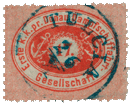 1866. 17 Soldi, vermilion.
1866. 17 Soldi, vermilion.
Genuine
Rather nicely lithographed, on thin, white wove paper; very badly perforated 9 1/2. I have seldom seen worse perforation on any genuine stamps; but probably the extreme thinness of the paper prevented the little punches from cutting out clean holes. The wavy lines which compose the groundwork, outside the central oval, are continued to the very edge of the stamp, where they are cut short off, without any boundary-line at all. The outer oval is formed of two lines, the inner of the two being much thinner than the other; and the letters of the upper inscription do not touch this thin inner line of the outer oval in any place, nor do the letters of the lower inscription touch the outline of the central oval anywhere either, or the line below them. The circle round the 17 is composed of one thick, dark, zig-zag line, between two similar, but thin ones. Both the anchors are well drawn. Both flukes of each anchor are perfectly distinct, and so are the cables twisted round their shanks. There is a single, large round stop after the 17. The stop after the first little K in the upper inscription is tolerably round; that after the second K is slightly diamond-shaped; that after PR is square, and that after GESELLSCHAFT is also square, and fully as large as any of the others. The middle tongue of the E of ERSTE is placed centrally; that is to say, in the middle of the letter. The thin, inner line of the outer oval is not broken anywhere. The bottoms of all the letters which end in straight strokes are cut off square. The top of the T of GESELLSCHAFT, above the cross-bar, is as thick as that part of the lower stroke which touches the cross-bar; the said lower stroke being slightly wedge-shaped, and thickest at the bottom.
First Forgery
Lithographed, on moderately stout, white wove paper, which shows the meshes of the gauze on which it was made very distinctly, despite the thickness of the paper. I do not remember ever seeing just the same kind of paper before: when held up to the light it shows light points, on a very regular, dark lattice-work. The perforation is compound, 12 1/2 by 13; not very well done, but better than that of the genuine. There is no shading on either of the anchors, though both are shaded in several places in the genuine. The portion of rope, from the eye or ring of the anchor to the stock or cross-bar on each side, is marked with oblique lines, to represent the strands, the same as the rest of the rope; but in the genuine, this portion of each rope is white, and destitute of strands. The lower end of the right-hand rope has the marks of the strands only for about half its length, being white at the end; while, in the genuine, it has the strand-marks to the very end, just like the left-hand rope. There is no stop after the 7, which has a very curly head, instead of the flat head of the genuine, and the tail of the said 7, which ought to be cut off very sharply and sloppingly, is rounded. All the stops, including the one after GESELLSCHAFT, are small and round. The middle tongue of the E of ERSTE is considerably nearer to the head than to the foot of the letter. The thin, inner outline of the outer oval is broken in several places. The bottoms of several of the letters are rounded, instead of being cut off square. The T of GESELLSCHAFT is much thinner above the cross-bar than it is below it, and the part below the cross-bar is straight, instead of slightly wedge-shaped. Notwithstanding all these differences, this forgery looks very well, especially as the forgers generally manage” to conceal the curly head of the 7 by drawing the cancellation-bar right across it.
Second Forgery
Lithographed, on smooth, very white wove paper, thicker than that of the genuine; pin-perf. 13. There is a thin boundary-line all round the stamp; but the forgers often cut off the perforations, and then, of course, the said thin line disappears. In the upper inscription, all the taller letters touch the boundary-line above them; and, in the lower inscription, all the taller letters touch the outline above them, and most of the letters touch the line below them. The circle round the 17 is very indistinct and blotchy, but the inner zig-zag circle appears to be about the same thickness as the middle one, and the outermost one runs into the solid background in several places. There is a stop before the head of the 1, another before the foot of the 1, and a large one, followed by a smaller one, after the 7. The 7 is the same shape as the genuine. All the stops in the inscription are round, or very nearly so; the one after GESELLSCHAFT being a good deal too small. The thin, inner line of the outer oval is broken in many places. Only one or two of the letters are cut off square at the bottom, the rest being more or less rounded. The T of GESELLSCHAFT is very thick and clumsy. In the genuine stamps, of all the values, there are thirteen convex waves to be counted, in the wavy lines of the background; but this forgery only shows nine. The lettering is all decidedly ragged, and this counterfeit ought not to deceive; yet I find it in most of the albums sent to me for inspection.
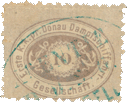 1866. 10 Soldi, mauve.
1866. 10 Soldi, mauve.
Genuine
This is exactly like the genuine 17 Soldi, above-described, except for the alteration in the numerals; so that the tests for the 17 Soldi will serve for this stamp.
First Forgery
This is an absurd production, not likely to deceive anyone. It is on very thick, white wove paper, and looks almost as though done with pen and (violet) ink. I think it will be sufficient to say that the perforations have been apparently cut with scissors, a la serpentine; the lines of the background are very nearly straight, and the first letter of DAMPF-SCHIFFAHRT is spelt with a J, instead of a D; besides which there is no stop after the 10.
Second Forgery
Lithographed, on medium, hard, white wove paper; unperforated, or pin-perf. 13. This is exactly the same as the second forgery of the 17 Soldi, with the value altered.
1868. 10 Soldi, green.
Genuine
Lithographed, on thin, white wove paper, perf. 95. This is usually much better printed than the 17 Soldi, but the design is the same; and, except for the alteration in the numerals, the tests are also the same.
First Forgery
Lithographed, on moderately stout, white wove paper, unperforated. The paper and impression are exactly like those of the first forgery of the 17 Soldi, except that the numerals are altered. There is no stop after the 10.
Second Forgery
Lithographed, on smooth, very white, very finely-wove paper, unperforated. Except for the alteration in the numerals, this is exactly the same as the second forgery of the 17 Soldi. The colour is a bluish green, very different from the decidedly yellow-green of the genuine.
1871. 10 Soldi, red.
Genuine
Lithographed, on thin, white wove paper, perf. 9 1/2. The design is the same as that of the genuine 17 Soldi, with altered numerals.
Forged
I have only one forgery of this stamp. It is lithographed, on thin, very smooth and shiny, very white, finely-wove paper, unperforated. The design is the same as that of the second forgery of the 17 Soldi, with altered numerals. The stop after the 10, which is decidedly large in the genuine, is small in this forgery, and midway between the o and the zig-zag circle; whereas, in the genuine, the stop is much nearer to the circle than to the o. I hardly think this last counterfeit is very common.
Postmarks
Genuine.—The genuine stamps are not often to be met with post-marked; unless the black bar with which many are furnished is a postmark; but I fancy this may have been the cancellation of surplus stock, as in the three bars of the Spanish stamps. I have one stamp cancelled with a large circle in blue, containing GALATA in large letters, together with some numerals.
Forged.—The forgeries have the postmarks 4, and 101, and also the Austrian cancellation of K. K. ZEITUNGS-EXPEDITION, in a large, single circle.
Reprints
These date from 1877. The paper is thicker, the colours are brighter, and they are perf. 10, instead of 9 1/2, but are also found unperforated.
From: ‘Album Weeds’, 3rd edition by R. B. Eareé. 1906
![]() See also –> Spud Papers – Danube Steam Navigation Company
See also –> Spud Papers – Danube Steam Navigation Company

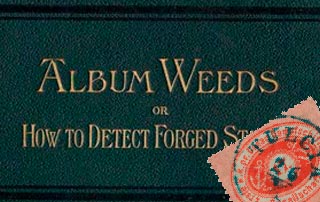
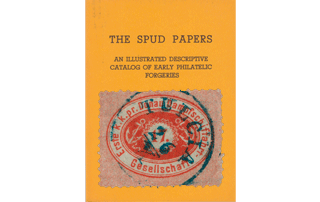
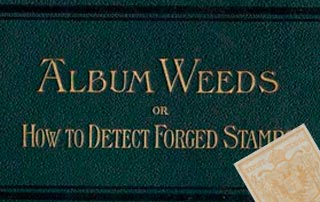
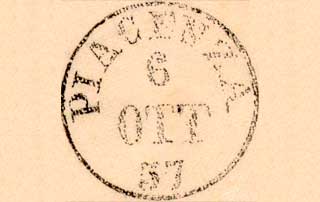
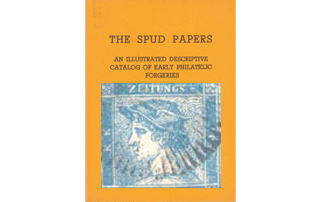
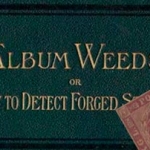
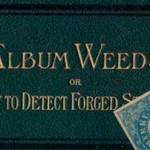
Leave a Reply
Want to join the discussion?Feel free to contribute!